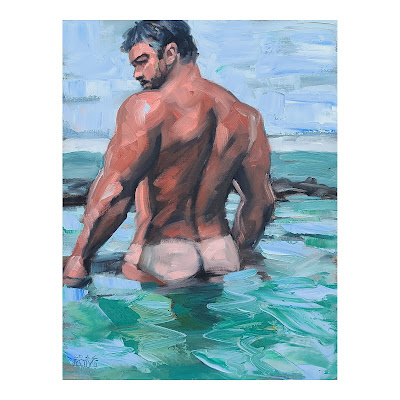Lowtide, 18x24 inches oil on canvas panel by Kenney Mencher
A painting of a thot "bear" bottomed man standing in the water of in the ocean or a lake. His muscular back and pale ass cheeks are facing the viewer while he casts an inviting almost sardonic look over his shoulder. He stands in a seascape drenched in light against a blue sky and green and blue waters.
This male portrait of a very masculine sexy hairy man is an original painting. I mainly make art about gay bears and other types of art for the queer community. A lot of my art revolves around the portrayal of heroic older bearish or bullish men. In my paintings I'm trying to communicate about body positivity and the beauty of the heroic male "bear."
Many straight folks are unaware of the bear subculture. Hardly a surprise, since a powerful majority rarely concerns itself with the doings of a marginalized minority. When, three or four years ago, I first mentioned bears to my straight friends, none of them knew what I was talking about, though by now at least one of them calls me “The Bear.” Similarly, my heterosexual students, as expert as they might be on current media, seem equally ignorant about this topic.
Most GLBT folks, however, by now seem to know the basics. A “bear” is a hairy, bearded, brawny-to-bulky gay man, usually displaying aspects of traditional masculinity. A cub is a younger version of the same; a wolf is a lean, hairy man; an otter a young version of that. “Woof!” is a lustful expression, meaning essentially: “Tasty! I’d like to climb all over that!” “Grrrrr!” means much the same. As you can see, after twenty-some years of development, the bear community, like any subculture, has its own jargon, sometimes called “bearspeak” or “vocabulary.” It also has its own values, its own style, and its own commodities. There are bear-oriented bars, festivals, music, movies, magazines, and books. There are regional clubs for bears not only in metropolitan centers, where the communities first developed, but also in rural areas.
This painting was done in the "alla prima" method. The alla prima is an Italian phrase that means 'at first attempt'. It refers to a wet-on-wet approach whereby wet paint is applied to previous layers of still-wet paint, often in a single sitting. Over the years, the technique has been adopted and adapted by artists from Van Gogh to Velázquez.
In particular I try to approach painting in several ways, I want the drawing skills, color, and anatomy to be accurate but I also try to make the compositions more interesting by avoiding a “bull’s eye” (symmetrical) composition in favor of a more exciting slightly off center or “asymmetrical” composition. Using a compositional rule called the "rule of thirds."
The rule of thirds is a composition guideline that places your subject in the left or right third of an image, leaving the other two thirds more open. While there are other forms of composition, the rule of thirds generally leads to compelling and well-composed shots.
I’m also attempting to work with brush work and thick and thin paint in a more stylized and calligraphic way. I want the paint to be thickest where the light is the brightest and thinner in the darker areas. The direction of the brush strokes is meant to follow and amplify the contours of the forms and make it feel more tangible.
The subject matter of most of my work is usually blatantly homoerotic or at the very least queer. I’m trying to ally with other queer and gay creators in representing people who are often marginalized by the rest of the world and make art that speaks to a community that often is silenced.
Information about the artist Kenney Mencher.
I was born in Brooklyn February of 1965. During much of my childhood I lived in Brooklyn, the Bronx, upstate NY, Sarasota, Florida and Manhattan. (Both my mother and father divorced and remarried.) The real hero of my childhood is my older brother Marc who literally changed my diapers, acted as my protector and as my role model.
I started to learn to paint and draw when I was six or seven years old and was convinced that I would be an artist from that age on.
As a teen at the High School of Art and Design I got my best training in Irwin Greenberg’s class where he taught me how to draw, oil paint and watercolor. I also attended classes at the Cooper Union and Art Students League.
My parents threw me out in my senior year of high school, so I earned my GED and worked construction on the Lower East Side of Manhattan. It was a rough time but my older brother and his partner Kirk rescued me by inviting me to move with them to Cincinnati, Ohio to live and study. While a college student, I worked in restaurants and painted as much as I could. After a year at the University of Cincinnati, I went back to the Bronx where I finished college at CUNY Lehman. Lehman is a fantastic college.
After completing my undergraduate studies, I lived in California and then Ohio completing my two masters’ degrees in Art History and Studio Art. After school I was lucky enough to have dual careers as an exhibiting artist and tenured professor.
In 2014 I began to work on paintings with a strong homoerotic content. Despite excellent sales and well received shows, the galleries I worked with wouldn’t show my new queer work, so I’ve been successfully working mainly directly with my collectors. This change has freed me and allowed me to focus on themes and subjects that, in the past, were rejected or resulted in censorship.
Things are going great! In 2016, after eighteen years of teaching art history and studio courses, I resigned a tenured professorship to pursue painting full time.


No comments:
Post a Comment